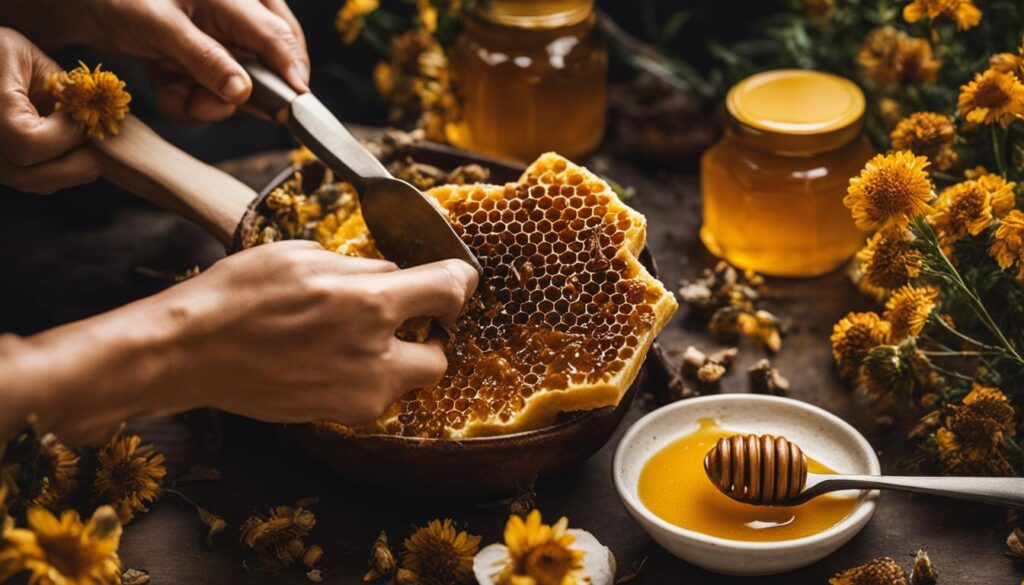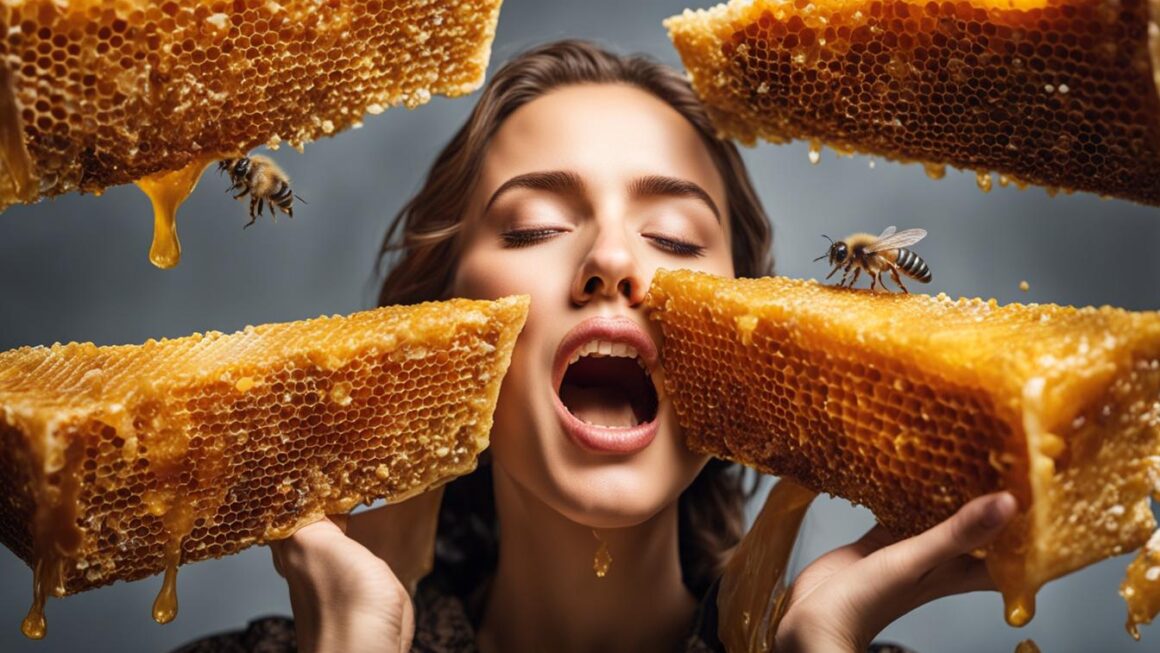Many people are curious about the possibility of consuming a whole honeycomb. While honey is a common and widely consumed food, the idea of eating the entire structure can seem daunting. In this section, we will explore the topic of honeycomb consumption, including its safety, nutritional value, and potential health benefits.
Key Takeaways:
- Honeycomb is an intriguing and unique food that offers numerous potential health benefits.
- While consuming a whole honeycomb is safe, it is crucial to source it from reputable and ethical beekeepers.
- Honeycomb is a nutrient-dense food that contains essential vitamins and minerals.
- There are various ways to include honeycomb in your diet, from using it as a unique ingredient in recipes to enjoying it as a standalone snack.
- Supporting sustainable beekeeping practices is essential for the continued availability of honeycomb and other bee products.
The Fascinating World of Honeycomb
When we think of honey, we typically picture a golden, viscous liquid poured over pancakes or used to sweeten tea. However, honey also comes in a solid form known as honeycomb. Honeycomb is a beautiful creation of bees and serves as the structure for honey storage in beehives.
Honeycomb Structure and Production
The hexagonal shape of honeycomb cells is nature’s way of maximizing storage space, providing the bees with the most substantial amount of storage while using the least amount of wax. The intricate design of the honeycomb consists of beeswax and is produced by bees through a process of wax secretion.
Worker bees consume honey and convert it into wax, which is then molded and shaped to create the familiar hexagonal pattern that we recognize as honeycomb. The creation of honeycomb requires significant effort and teamwork from the bees in a colony.
Honeycomb Consumption and Edibles
Honeycomb is edible and can be consumed raw or incorporated into various recipes. The waxy cells of the honeycomb are entirely edible, although some people prefer to chew the wax and then spit it out.
Honeycomb is a popular addition to cheese platters and charcuterie boards, adding a unique texture and flavor to the spread. It is also enjoyed as a topping for toast, yogurt, and ice cream, among other things.
Some more adventurous individuals enjoy eating a whole honeycomb, comb and all, although this may not be suitable for everyone. For those looking to incorporate honeycomb into their diet, various recipes can be found online, such as honeycomb cookies or honeycomb candy.
“Honeycomb is edible and can be consumed raw or incorporated into various recipes.”
Is It Safe to Eat a Honeycomb?
Consuming honeycomb is generally considered safe for most people. However, it is essential to exercise caution and ensure the honeycomb is sourced from reliable and ethical beekeepers. Raw honeycomb, which has not been processed or heated, may contain harmful bacteria or other contaminants, particularly if it has been sourced from poorly managed hives or contaminated environments.
If you have a severe allergy to bee stings or bee products, it is best to avoid consuming honeycomb or any other bee-related product, as it may trigger an allergic reaction. Additionally, if you have a medical condition that affects your immune system, you should consult your doctor before consuming honeycomb or any other raw food.
When preparing to consume honeycomb, it is recommended to start with small amounts and chew it thoroughly to avoid any potential choking hazards. The wax of the honeycomb is indigestible and should be spat out after the honey has been extracted.
“Raw honeycomb, which has not been processed or heated, may contain harmful bacteria or other contaminants, particularly if it has been sourced from poorly managed hives or contaminated environments.”
Benefits of Heating Honeycomb
Heating honeycomb can help eliminate any potential bacteria and make it safer to consume. However, heating honeycomb can also cause it to lose some of its nutritional value. When heated, the beeswax melts, and the honey separates from the wax, resulting in a more liquid texture. Additionally, the heat can damage or destroy some of the enzymes and antioxidants that make honeycomb a superfood.
If you choose to heat your honeycomb, it is recommended to do so at a low temperature and for a short period to minimize nutrient loss. You can also consider using honeycomb as an ingredient in cooked dishes, such as glazes or marinades, instead of eating it raw.
Exploring the Nutritional Value of Honeycomb
Honeycomb is not just a delicious treat; it also offers several nutritional benefits. The nutritional value of honeycomb varies depending on the type of honey, the flowers the bees visit, and the region it is produced in.
Here is a breakdown of the essential nutrients found in honeycomb:
| Nutrient | Amount per 100g of Honeycomb |
|---|---|
| Calories | 342 |
| Protein | 1.3g |
| Fat | 0.1g |
| Carbohydrates | 84g |
| Vitamins and Minerals | Vitamin C, Calcium, Iron, and Magnesium |
Honeycomb is a rich source of carbohydrates, providing a sustained energy boost. It also contains essential vitamins and minerals, making it a valuable addition to a healthy diet. Vitamin C found in honeycomb is an antioxidant that helps the body fight free radicals. Calcium is essential for strong bones and teeth, while iron and magnesium play a vital role in maintaining healthy blood flow and muscle function. Honeycomb also contains trace amounts of various other nutrients, including vitamin A, vitamin B6, and zinc.
Consuming honeycomb may also have several potential health benefits, including aiding digestion and boosting the immune system. The antibacterial properties of honeycomb may also help prevent infections in the body.
Comparing the Nutritional Value of Honeycomb and Honey
Here is a comparison of the nutritional value of honeycomb with liquid honey:
| Nutrient | Honeycomb (per 100g) | Liquid Honey (per 100g) |
|---|---|---|
| Calories | 342 | 304 |
| Protein | 1.3g | 0.3g |
| Fat | 0.1g | 0g |
| Carbohydrates | 84g | 82g |
| Vitamins and Minerals | Vitamin C, Calcium, Iron, and Magnesium | Vitamin C, Calcium, Iron, and Magnesium |
While both honey and honeycomb offer similar nutritional benefits, honeycomb contains slightly more calories and carbohydrates. However, honeycomb is a more nutrient-dense option, offering more protein than liquid honey. Additionally, honeycomb contains beeswax, which is rich in propolis, a compound known for its potential anti-inflammatory and antiviral properties.
How to Eat a Whole Honeycomb
Eating a whole honeycomb may seem intimidating, but it can be a delicious and nutritious addition to your diet. Here are some tips on how to consume a honeycomb:
- Slice it: Cut the honeycomb into thin slices and enjoy it on toast, crackers, or with cheese.
- Chew it: Simply chew on a small piece of the honeycomb to release the sweet honey inside.
- Blend it: Blend the honeycomb with your favorite smoothie ingredients for a delicious and nutritious drink.
It’s important to note that while honeycomb consumption is generally safe, it’s crucial to ensure that the honeycomb is sourced from reputable and ethical beekeepers to avoid any potential contamination.
What Does Eating a Whole Honeycomb Taste Like?
The taste of eating a honeycomb is a unique experience. The honeycomb is made up of beeswax and honey, giving it a sweet and slightly floral taste. The wax has a chewy texture that can be compared to gum. The freshness of the honeycomb is crucial to the taste, so be sure to purchase it from a reputable source.
Overall, eating a whole honeycomb can be a fun and tasty way to enjoy the natural goodness of honey and bee-produced wax.

Health Benefits of Eating Honeycomb
Eating honeycomb offers numerous health benefits, making it a popular choice among health enthusiasts. Here are some of the top health benefits of consuming honeycomb:
| Benefit | Description |
|---|---|
| Antibacterial properties | Honeycomb contains enzymes that produce hydrogen peroxide, which gives it antibacterial properties. Eating honeycomb can help fight off harmful bacteria in the body. |
| Rich in antioxidants | Honeycomb contains high levels of antioxidants, which can help reduce inflammation and lower the risk of chronic diseases such as heart disease and cancer. |
| Improved digestive health | Consuming honeycomb can help improve digestive health by promoting the growth of good bacteria in the gut. |
| Boosts immune system | Honeycomb contains antimicrobial compounds that can boost the immune system and help fight off infections. |
In addition to these health benefits, honeycomb is also a great source of natural energy. It contains complex carbohydrates that provide sustained energy throughout the day.
To get the most out of honeycomb’s health benefits, it is essential to source it from a reliable and ethical beekeeper. Additionally, it is crucial to exercise caution when consuming honeycomb to avoid any potential risks.
Culinary Uses of Honeycomb
Aside from its nutritional benefits, honeycomb is also a versatile ingredient in the culinary world. Its unique texture and flavor profile make it a popular addition to various dishes and recipes. Some of the popular ways to consume honeycomb include:
- Adding chunks of honeycomb to a cheese board
- Spreading honeycomb on top of toast or crackers
- Serving it alongside fresh fruit or yogurt
- Incorporating it into baked goods, such as muffins or bread
- Using it as a topping for ice cream or desserts
Honeycomb can also be used as a natural sweetener in place of traditional sweeteners like sugar or honey. Its unique texture and flavor can add depth and complexity to dishes, making it a favorite among foodies and chefs alike.
Recipe Idea: Honeycomb and Almond Granola
For a delicious and nutritious breakfast or snack, try making your own honeycomb and almond granola. Here’s a simple recipe to try:
- Preheat your oven to 325°F.
- Mix together 4 cups of rolled oats, 1 cup of sliced almonds, 1/2 cup of honey, 1/4 cup of coconut oil, and a pinch of salt in a large bowl.
- Spread the mixture evenly on a baking sheet lined with parchment paper.
- Bake for 20-25 minutes, stirring occasionally, until the granola is golden brown and crispy.
- Once cooled, add small chunks of honeycomb to the granola and mix well.
“Honeycomb is such a versatile ingredient and can add a unique flavor and texture to so many dishes. It’s also a great natural sweetener and alternative to traditional sugars.” – Chef John Smith
Honeycomb in Traditional Medicine
In addition to being a delicious edible, honeycomb has a rich history in traditional medicine practices. Its medicinal properties have been recognized for centuries, with ancient cultures using honeycomb to treat a variety of ailments.
One of the most well-known uses of honeycomb in traditional medicine is for its antibacterial properties. Studies have shown that honey has potent antibacterial activity against a wide range of bacteria, including antibiotic-resistant strains. The high sugar content in honeycomb creates an environment that inhibits the growth of harmful bacteria, making it a natural remedy for treating wounds, burns, and other skin infections.
“Honey has been described as an ‘ideal wound dressing’ due to its antibacterial properties and ability to promote wound healing.”
Source: NCBI
Honeycomb is also rich in antioxidants, which are beneficial compounds that protect your body from damage caused by free radicals. Free radicals are unstable molecules that can harm cells and contribute to the development of chronic diseases. Antioxidants neutralize free radicals, reducing the risk of oxidative damage and improving overall health.
Additionally, honeycomb has been known to have a positive impact on digestive health. The high fiber content in honeycomb can improve digestion and help regulate bowel movements. Honeycomb has also been found to have mild laxative properties, making it a gentle and natural remedy for constipation.
While the use of honeycomb in traditional medicine is well-established, it is important to note that it should not be used as a substitute for medical treatment. If you are experiencing any health issues, it is always best to consult with a healthcare professional.
Overall, honeycomb’s medicinal properties make it a versatile and valuable ingredient in both traditional medicine and modern healthcare. Its antibacterial and antioxidant activity, along with its positive impact on digestive health, make it a natural and effective remedy for a variety of ailments.
Honeycomb and Sustainability
As consumers become more environmentally conscious, it is essential to consider the sustainability aspect of consuming honeycomb. Supporting local beekeepers who use sustainable beekeeping practices is crucial in maintaining a healthy bee population and promoting biodiversity. By choosing to consume honeycomb, you are supporting ethical beekeeping practices that prioritize bee welfare and the environment.
Did you know that honeybees are responsible for pollinating approximately one-third of all the food we eat?

This image showcases the intricate structure of a honeycomb. It is fascinating to note that each hexagonal cell is precisely measured and designed to store honey and bee larvae efficiently.
Honeycomb consumption is an excellent way to promote sustainable living practices while also enjoying the nutritional benefits of honey.
Conclusion
Can you eat a whole honeycomb? This question has been explored in detail throughout this article, and we have found that consuming honeycomb is not only safe but also offers a range of nutritional and potential health benefits. However, it is essential to ensure that the honeycomb is sourced from reliable and ethical beekeepers to ensure its safety and sustainability.
Whether you choose to enjoy honeycomb on its own, as a unique ingredient in recipes, or for its potential therapeutic properties, it is crucial to exercise caution and moderation when consuming it.
Overall, honeycomb eating is an intriguing aspect of beekeeping and provides a fascinating glimpse into the natural world of bees. By supporting sustainable beekeeping practices and enjoying locally sourced honeycomb in moderation, we can not only benefit ourselves but also contribute to the preservation of our environment.
FAQ
Can you eat a whole honeycomb?
Yes, it is possible to eat a whole honeycomb. However, it is important to consider the safety and feasibility of consuming it.
What is the significance of honeycomb in beekeeping?
Honeycomb plays a vital role in beekeeping as it is the structure where bees store their honey, raise brood, and create a home for the colony.
Is it safe to eat a honeycomb?
Generally, it is safe to consume a honeycomb. However, individuals with specific allergies or sensitivities should exercise caution and consult with a healthcare professional.
What are the nutritional benefits of honeycomb?
Honeycomb contains essential nutrients such as carbohydrates, vitamins, minerals, and antioxidants. It can provide energy and potentially offer health benefits.
How can I eat a whole honeycomb?
There are various ways to consume honeycomb, including eating it as it is, spreading it on toast or crackers, or incorporating it into recipes as an ingredient.
What health benefits can be derived from eating honeycomb?
Eating honeycomb may have potential antibacterial properties, antioxidant benefits, and positive effects on digestive health. However, further research is needed.
How can honeycomb be used in cooking?
Honeycomb can be used as a unique ingredient in recipes, as a topping for desserts or cheese platters, or simply enjoyed on its own for its distinct flavor and texture.
Are there any traditional medicinal uses for honeycomb?
In traditional medicine practices, honeycomb has been used for its potential therapeutic benefits, such as soothing sore throats, promoting wound healing, and supporting overall health.
What is the sustainability aspect of honeycomb consumption?
Consuming honeycomb supports local beekeepers and sustainable beekeeping practices, which are essential for maintaining healthy bee populations and preserving biodiversity.
Can you eat a whole honeycomb without any risks?
While eating a honeycomb is generally safe, it is important to ensure it is sourced from reliable and ethical beekeepers to minimize the risk of contamination or exposure to harmful substances.




